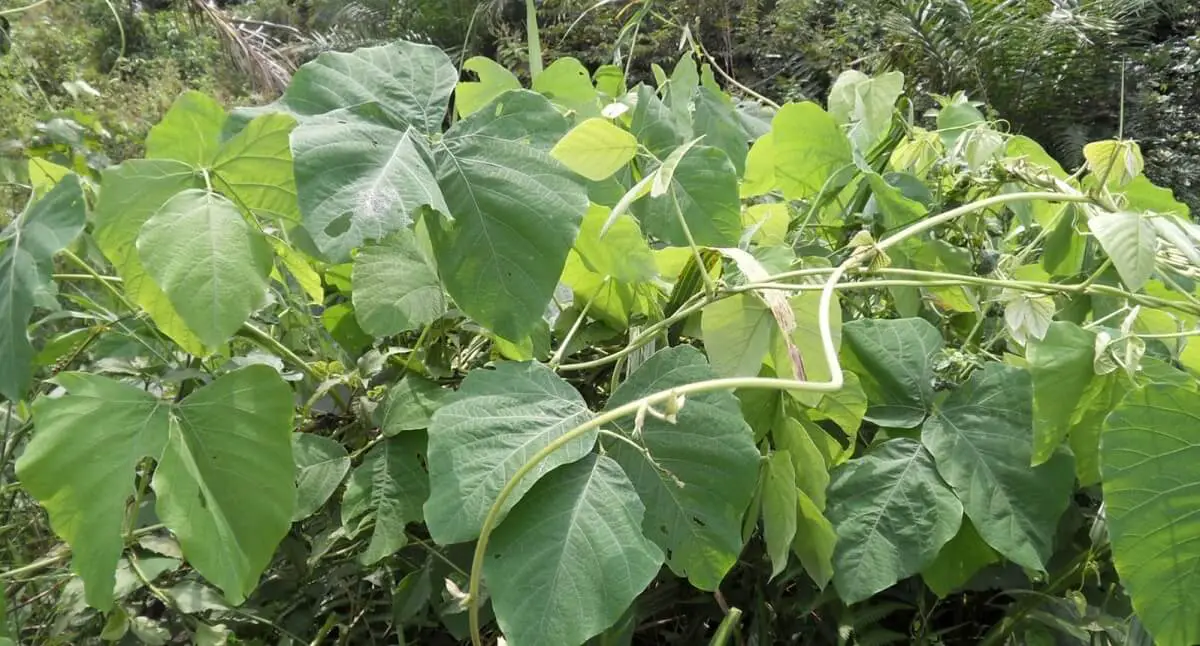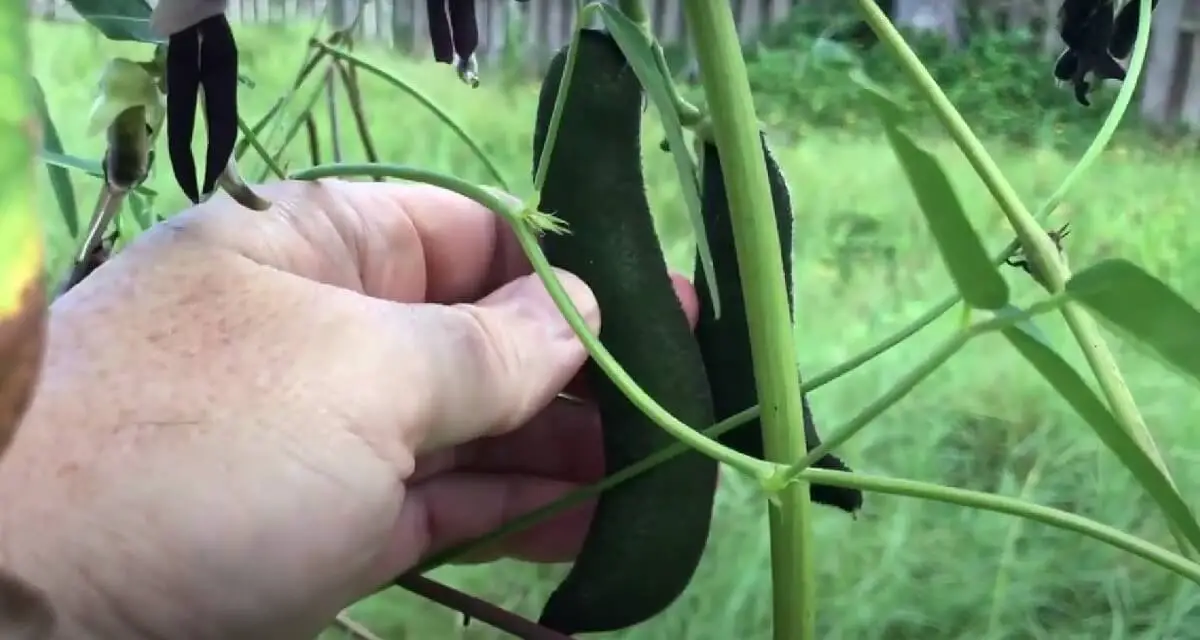How to Grow Velvet Beans Guide What You Need To Know
Velvet Beans A Green Manure Cover Crop

The velvet bean is a long climbing vine tropical legume, making white or purple flowers with deep purple bean pods. They have gained popularity as a medicine, cover crop, forage crop, source of green manure, and to a small extent, food.
Being a legume family member means you can use it as an organic method of adding nitrogen to your soil.
It is not legumes themselves that move the nitrogen into our soil. The bacteria rhizobia need to be present in your soil to have this conversion.
The velvet bean will capture the nitrogen in the air, moving it to its roots where this bacteria will convert it into a usable format for other plants.
It is native to southern China and India that, has spread throughout most of southern China, and is now cultivated around most of the world.
The velvet bean has many other names that gardeners might have heard monkey tamarind, velvet bean, Bengal velvet bean, Florida velvet bean, Mauritius velvet bean, Yokohama velvet bean, cowage, cowitch, lacuna bean, and Lyon bean.
I do not advise eating it since it is toxic and requires a specific process to make it properly edible.
I recommend just using it as a cover crop to help improve the quality of your soil. Then till it into the ground as a source of green manure to further enhance your soil quality.
The velvet bean creates extremely long vines that can reach up to 60 feet long.
It is not a frost-hardy plant. If you need something that can survive through winter, look at our winter pea guide.
The 90-day flower variety has explicitly been bread to remove most of the velvet fuzz from them, making them a lot easier to work with and way less itchy.
Is Velvet Beans an Annual Crop or Perennial Crop
Where they get planted will determine if they are an annual or perennial crop type.
The plant is technically a perennial, but in the United States and Canada, it gets treated as an annual.
Even in hot climates, it is usually grown as an annual but in hotter tropical climates and can get used as a biennial.
What Do Velvet Beans Plants Look Like
The velvet bean is an annual legume that you should wear gloves when touching. The fine hairs on the pods and leaves can create intense itchiness.
Roots: the velvet bean has a taproot with spreading fleshy lateral roots extending as long as 20 to 30 feet near the surface of the soil.[3]
Leaves: The plant got its name because the leaves are covered in fine hair, making them feel like velvet when touched. The leaves have a heart-shaped look to them.
Stems: The stems are striated, smooth, or can have a slightly purple shade.
Flowers: The flowers on the velvet bean are self-pollinating with short pedicels with white, lavender to dark purple colors on the corollas.
Pods: The pods can grow to 6 inches with 3 to 6 beans inside the pod. They will begin as a more yellowish color turning green, and get covered in soft black, white, or grey hairs. This gives them a velvety feel and the color of the hairs growing on them.

Velvet Bean Germination Time
On average, any variation of pea will take between 7 and 30 days for germination to happen.
You can speed up the process if you put the seeds in water, let them soak in the water for one to two days, and then plant them.
For the velvet bean, you need to plant it in late spring or early summer. We need the soil to reach a temperature of at least 65 degrees F. (18 C).
Velvet Bean Fertilizer Requirments
You will not need to add any fertilizer when growing velvet beans.
If you want to add fertilizer to maximize its growth, focus on a fertilizer that does not have nitrogen. Something like an N.P.K. OF 0-10-0 or 0-10-10 will work well.
We do not need to add any form of external nitrogen since the velvet bean will naturally fix nitrogen in the soil. The one nutrient the plant does respond well to is phosphorus.
How to Grow Velvet Beans
The velvet bean likes to get planted in well-draining soils with a pH level between 5 and 8. If your ground is commonly water-logged, it is not likely for the plant to survive.
Before we plant our velvet beans, we will have to prepare the soil first. Use a spade to help break up the ground and provide better aeration. Use a garden rake to break up the dirt and level your garden plot.
For the best growth possible, we want our soil pH to be between 6 and 7, but it will still perform fine in a range between 5 and 8.
You will aim to plant the velvet seeds between .5 and 1.5 inches deep. We want the seeds to be deep enough to access the moisture while allowing them to sprout as quickly as possible.
Use a garden rake to remove an inch of soil and lay down your seeds.
Cover the seeds with the soil and water well, ensuring your garden plot is entirely soaked.
Velvet Bean Growth Stages
- 1) Germination
- 2) Seeding growth
- 2) Late vegetative
- 2) Early bud
- 2) Mid bud
- 2) Late bud
- 2) First bloom
- 2) Mid bloom
- 2) Full bloom
Are Velvet Beans a Good Cover Crop
When we add velvet bean plants to our gardens, it provides erosion control, suppresses weeds, and adds extra organic matter to our soil while acting as a topsoil protectant crop during drought.
The plant is also very highly resistant to insects. Velvet bean gets used for its ability to suppress nematodes.
Velvet beans will produce a high amount of biomass in a short time compared to other plants. The fast growth period allows us to collect a lot of organic matter in a short time.
The extra organic material makes it a good choice when looking for a source of green manure to further improve our soil's health, aeration, and fertility.
Velvet Beans as Green Manure
Velvet beans are a great way to naturally add extra nitrogen to our garden.
They can get tilled into our gardens, and because of their fast growth rate, we can quickly get a lot of additional organic matter for our soils.
Tilling it into the soil as it decomposes will release more nutrients into the ground while feeding beneficial organisms in the soil and improving soil aeration.
Summary
The velvet bean is a great cover crop to help protect our soils while providing a lot of extra organic material that we can till into our ground. When we till it into our garden, it will help feed beneficial microorganisms and worms, increasing the available nutrients.
While we can process the beans to make them edible, I would be cautious doing this. I do not feel comfortable enough to use this as a food source from my garden. If I plant it in my garden, I am only going to use it as a way to protect and improve my soil.
While you can add additional fertilizers if you want, I do not see the point of adding them. I am using it as a cover crop that I will just till back into the ground later.
Similar Articles
Planting Crimson Clover
Growing Scindapsus Aureum
Planting Winter Rye
Planting Winter Peas
[1]https://world-crops.com/velvet-bean/
[2]https://www.gardeningknowhow.com/edible/grains/cover-crops/velvet-bean-information.htm
[3]https://www.marysheirloomseeds.com/products/velvet-bean
[4]https://www.cambridge.org/core/journals/world-s-poultry-science-journal/article/abs/use-of-velvet-beans-mucuna-spp-as-a-feed-ingredient-for-poultry-a-review/379A2B7AE401E9518DF967FF6A7AB3EF
[5]https://ati.da.gov.ph/ati-car/sites/default/files/Velvet_Beans.pdf
[6]https://www.echocommunity.org/en/resources/398d94f4-59aa-4500-b535-a08e67f8d78b